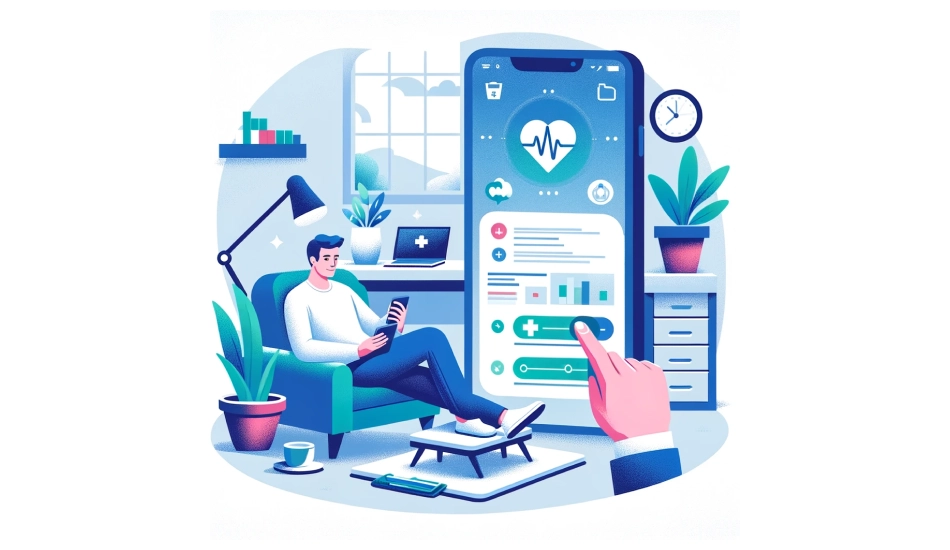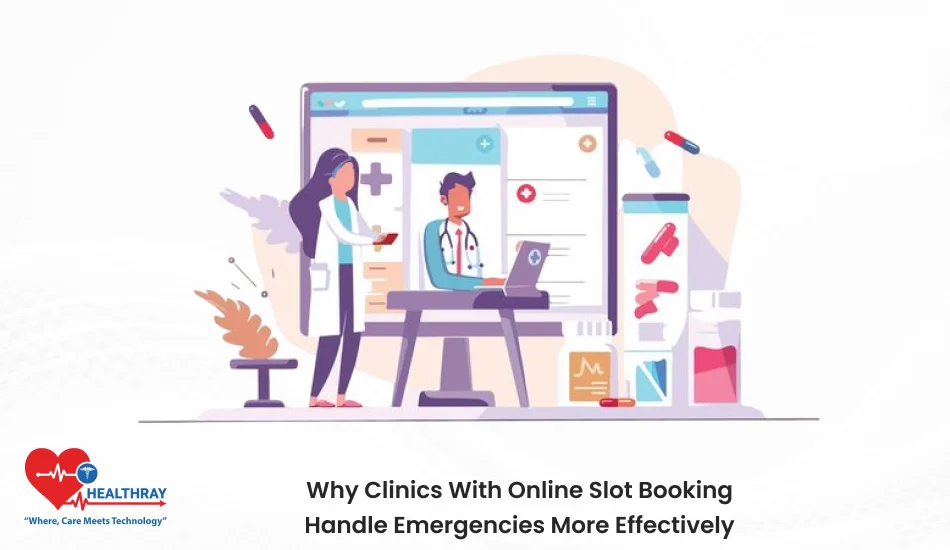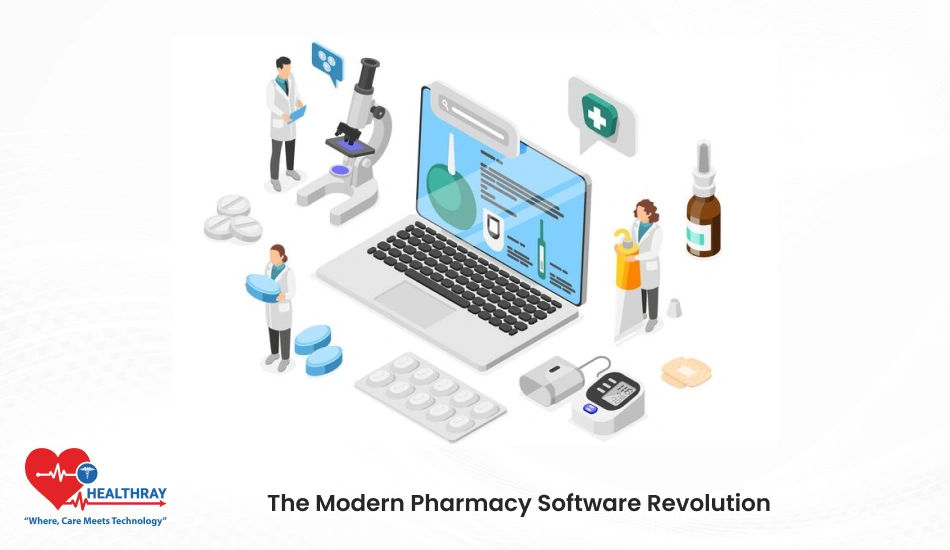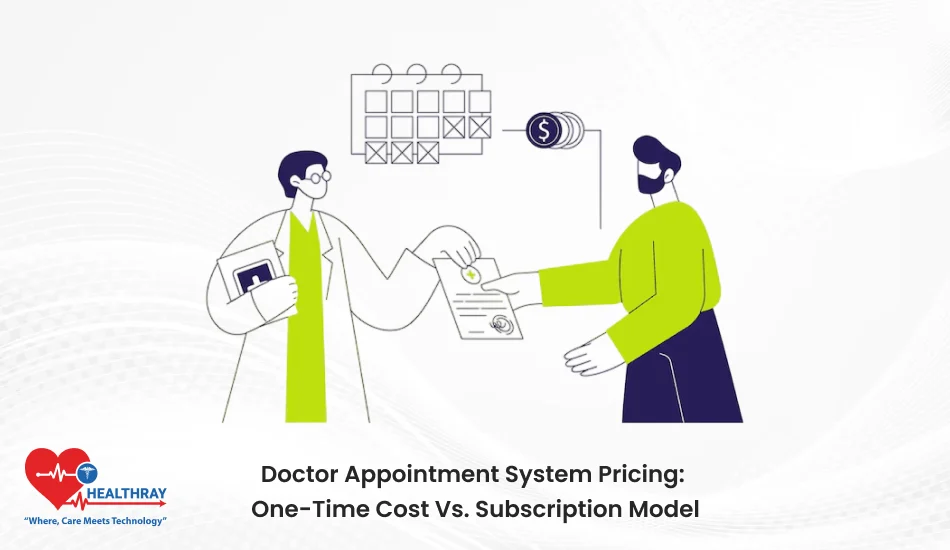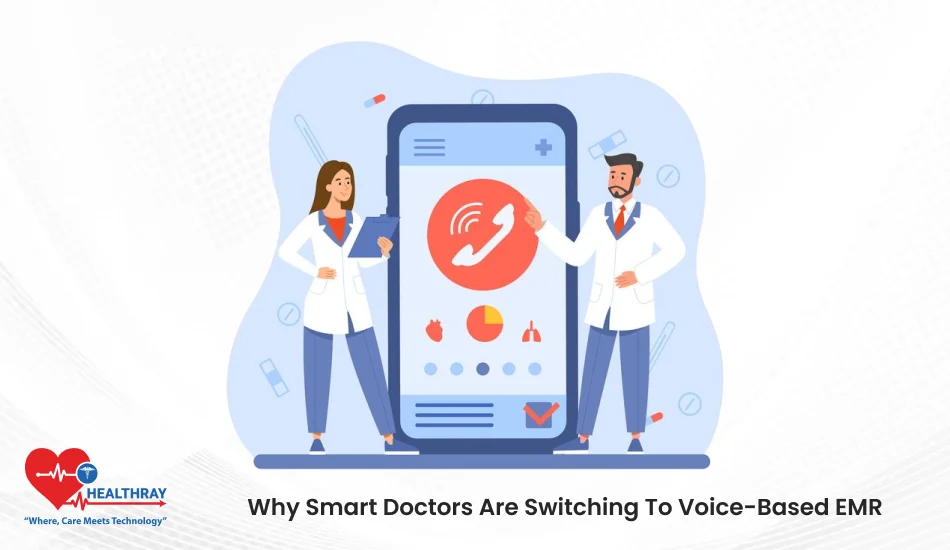Quick Summary: High-quality healthcare that piques patients’ interests is essential in this cutthroat age. And the only method to achieve this is to use or adapt cutting-edge technologies. Therefore, in order to do these jobs with ease, hospitals should put in place an Electronic Patient Monitoring System. You may select among the top 10 electronic patient management software packages by following this blog’s instructions.
Introduction
Electronic Patient Monitoring Systems, or EPMS, have become essential tools in a time when data-driven practices are revolutionizing healthcare and changing how patients engage with providers. These technologies transform the way healthcare practitioners give services and keep records by skillfully managing patient information and enhancing interaction. In order to achieve effectiveness, accuracy, quality reporting, and patient-centered treatment, EPMS is essential for solo practitioners, autonomous practices, and large institutions alike.
The crucial choice of selecting the best system from approved suppliers becomes more pressing as the need for Electronic Patient Records grows. By offering insights into important features and factors, this article seeks to assist you in choosing the ideal EPMS.
An Electronic Medical Record (EMR) system, also known as Electronic Health Record (EHR) system, is a centralised platform for safely storing and retrieving patient data. The transition to digital records eliminates problems associated with paper documentation and guarantees quick access to important data. Thus, patient safety and the quality of care are improved. Hence this guide will help you understand hospital management software development at a better level.
What Is An Electronic Patient Monitoring System?

Let’s start at the foundation and immerse ourselves in the definition of EPMS.
An online patient management system, often known as an Electronic Patient Monitoring System (EPMS), is a digital software tool used in the healthcare industry to effectively organize and preserve patient-related data. As explained in greater detail in this blog, the EPMS encompasses a number of applications that fall under the broad category of healthcare software. These applications include patient journey management software and others.
With its many capabilities, EPMS can do much more than just keep up-to-date patient information and make appointments. It can also handle invoicing processes, manage prescriptions, and supervise a variety of clinical and administrative operations. Through the smooth integration of these elements, EPMS is carefully designed to optimise medical procedures, improve patient care quality, and increase the overall effectiveness of healthcare institutions. Additionally, these systems offer safe access to patient data, guaranteeing that this priceless information may only be retrieved and managed by authorised healthcare personnel.
Kinds Of Software For Electronic Patient Monitoring Systems
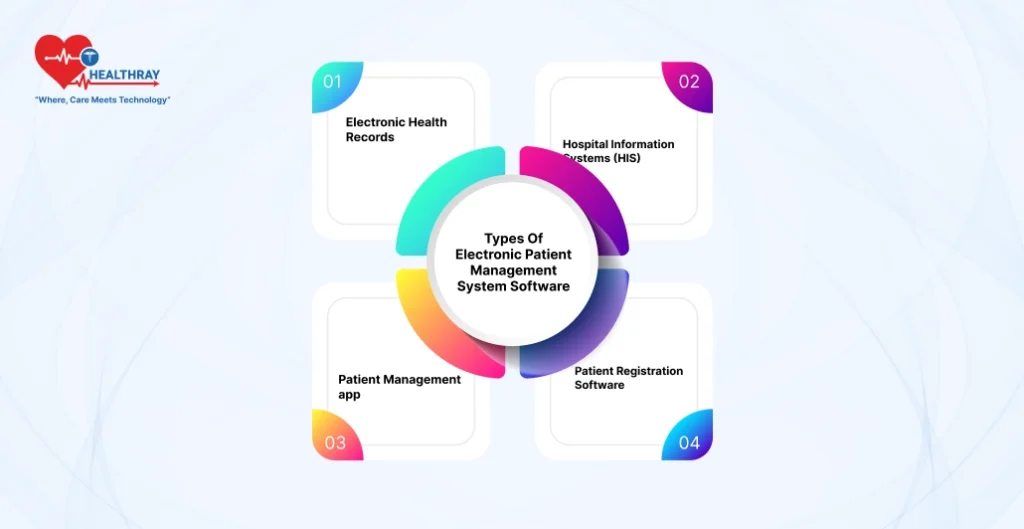
- Electronic Health Records
- Hospital Information Systems (HIS)
- Patient Registration Software
- Cloud Based Patient Management System
- Patient Care Management System
- Practice Management Software
- Telemedicine And Telehealth Platforms
- patient Information Management Systems
- Pharmacy Management Software
- patient management app
- Home Healthcare Software
- Rehabilitation Management Software
- Veterinary Practice Management Software
- Physical Therapy EMR Software
- Ophthalmology Practice Management Software
- Mental Health EHR Software
- Chiropractic EHR Software
- Dental Practice Management Software
- Portal Software
Using Electronic Patient Management Software Has Its Advantages

There are many benefits to using Electronic Patient Management software, and we have summarized some of the main ones here for your review:
Benefits of Electronic Patient Monitoring Systems:
Effective Document Management
By doing away with paper files, electronic patient management software simplifies the filing and keeping of medical records. Fast access to digitized patient histories, test results, and treatment plans allows medical professionals to make diagnoses more quickly and accurately. Patient data is safe and easily accessible because of this simplified efficiency, which also reduces the possibility of document loss.
Better Patient Care
By facilitating easy access to electronic medical records in an emergency, EPMS raises the standard of patient care. By making progress monitoring and drug reminders easier, it encourages patients to follow their treatment regimens. Fostering effective communication across healthcare teams leads to improved patient outcomes and effective treatment.
Appointment Scheduling
By enabling patients to make appointments online or via mobile devices, EPMS streamlines the appointment booking process and lowers the need for phone calls. Healthcare professionals are skilled at managing schedules, which lowers waiting times for patients and appointment overlap. Reminders that are sent automatically help reduce no-shows and maximise resource use for prompt care.
Billing and Payment Management
By automating these tasks, Electronic Patient Management System makes it easier to create precise invoices and keep track of payments. Patients may pay online and get electronic invoices, which makes medical facilities and patients more convenient. This technical skill reduces billing mistakes, speeds up the collection of payments, and helps physicians maintain financial stability.
Reduced Administrative Workload
By automating appointment scheduling, patient records, and prescription management, EPMS lightens the administrative load on healthcare staff. This translates to less paperwork and manual data entry, enabling staff to channel more focus into patient care. Streamlined communication within healthcare teams augments coordination, amplifying overall efficiency.
Enhanced Security
The system fortifies security for sensitive medical data, ensuring it resides securely and is accessible only to authorized personnel. This robust safeguarding of patient privacy aligns with healthcare regulations like HIPAA. Data backups and encryption add additional layers of protection, warding off unauthorized access or data loss.
Patient Engagement
EPMS enables patients by providing access to their medical records, scheduling appointments, and facilitating secure communication with healthcare providers. This empowerment fuels active patient participation in their healthcare journey, fostering improved health outcomes and strengthening the doctor-patient relationship. Here’s a great article to Benefits Of Patient Portal that will help you understand patient engagement.
Regulatory Compliance
By making sure healthcare facilities follow strict data privacy and security standards, electronic patient management software acts as a watchdog for regulatory compliance. By taking this defensive posture, healthcare organisations can avoid fines and legal issues while safeguarding patient information. It also fosters reliability, trust, and client satisfaction with healthcare services.
Cost Savings
EPMS becomes a sign of substantial cost savings for physicians by streamlining administrative activities, cutting paperwork, and minimising mistakes. It improves operational effectiveness, enabling efficient use of resources and reducing the financial burden on physicians and patients.
Interoperability
EPMS promotes interoperability, which allows various healthcare systems and gadgets to communicate with one other seamlessly. By providing physicians with access to patient records from many sources, reducing mistakes, and guaranteeing a seamless flow of health information, interoperability improves care coordination.
The Electronic Patient Management System’s Features

Let’s begin our investigation of Electronic Patient Management Systems (EPMS) by examining the many characteristics that influence its functionality:
Patient Information Management
This essential function stores and manages patient data, including contact information, medical history, and insurance information. It guarantees that medical professionals and personnel have a thorough understanding for efficient patient care.
Patient Intake Forms
Digital patient intake forms allow patients to submit personal and medical information online, modernising the paperwork process. By streamlining the check-in process, less paperwork is generated, allowing medical staff to access the most recent patient data.
Appointment Scheduling
The process of setting up patient visits is made simpler by appointment scheduling tools. Appointments may be easily requested and scheduled online by patients, cutting down on phone calls and administrative labour. This promotes improved scheduling, reduces the number of cancelled appointments, and improves overall patient care.
Prescription Management
Prescription management functions as a digital organiser for physicians inside an Electronic Patient Records, taking the place of paper-based prescriptions. It streamlines the medicine fulfilment process by saving time, lowering mistakes, and allowing chemists to easily obtain prescriptions.
Clinical Decision Support
This feature provides doctors with vital information about a patient’s status since it is outfitted with intelligent algorithms. It assists physicians in making well-informed treatment decisions and improves the standard of care by highlighting potential diagnoses, therapies, and probable problems.
Orders for Laboratory and Tests
This tool, which doubles as a healthcare checklist, enables medical professionals to place direct test requests via the system, cutting down on paperwork and guaranteeing precise order monitoring. Electronic returns of the results allow for quick examination.
Telemedicine Integration
This technology facilitates virtual doctor visits by allowing doctors and patients to communicate online via video calls, chat, or messaging. It guarantees accessibility and convenience, particularly when in-person doctor appointments present difficulties.
Patient Portal
Acting as a safe online platform, the patient portal provides users with access to test results, appointments, personal health information, and doctor communication. Patients are given the ability to efficiently handle their medical records.
Reporting and Analytics
To help with well-informed decision-making, this tool gathers information from patient records to spot patterns. This data is useful for healthcare analysis as hospitals and physicians use it for better patient safety, resource management, and treatment.
User Access Control
This feature ensures that patient health records are handled securely by limiting access to viewing and editing to authorised staff only. Unique access keys are given to various healthcare providers, protecting private information and upholding confidentiality.
Mobile Access
Using smartphones or tablets, mobile access in an EPMS enables medical professionals to check patient records, make appointments, and carry out other healthcare-related duties. It also promotes flexibility and accessibility.
Integration with Pharmacy Systems
Prescriptions sent directly to pharmacies expedites drug fulfilment and lowers mistake rates. Effective healthcare operations are ensured by this integration.
Patient Reminders
Prescription medicine regimens, test dates, and doctor appointments are adhered to by patients thanks to automated reminders sent via texts or emails.
Workflow Automation
Streamlining administrative duties, workflow automation streamlines and minimises mistakes by automating procedures like billing, appointment scheduling, and updating patient records.
Inventory Management
Inventory management keeps an eye on medications, equipment, and medical supplies in a hospital facility. It helps to assure resource availability when needed, cuts down on waste, and avoid shortages, all of which improve the effectiveness of healthcare operations.
Top 10 Electronic Patient Monitoring Systems

Healthray
Meet Healthray, your technological partner for effective patient care administration. This system handles patient health information with ease, enabling simplified treatment and empowering physicians and medical personnel. Healthray leads the healthcare industry into the digital age with features including quick access to patient information, effective appointment scheduling, and a streamlined invoicing procedure. They have in Electronic Patient Records Software for streamlining hospital workflow.
Main Advantages of Healthray:
- Simple access to health records
- Simplified appointment booking
- Effective handling of insurance claims and billing
Dr. Chrono
Introducing DrChrono, the medical professional’s digital assistant that is transforming patient care. With features like mobile accessibility for physicians on the go, integrated medical billing, and thorough patient charting, this all-inclusive system provides medical offices with a centralised platform.
Major Advantages of DrChrono:
- Thorough patient documentation
- Drone access for physicians on the go
- Integrated medical billing that runs smoothly
HelpSquad
HelpSquad’s Virtual Medical Assistant service provides a reliable, HIPAA-compliant way for healthcare practices to eliminate administrative overload and enhance patient support. Their trained VAs handle appointment scheduling, insurance verification, EHR updates, patient communication, and both front- and back-office tasks with exceptional efficiency. By integrating a Virtual Medical Assistant into your workflow, your team can focus more on delivering quality patient care while HelpSquad manages the rest. This cost-effective model offers flexible hours, 24/7 support, and easy scalability as your practice grows, making it ideal for clinics of all sizes.
Main Advantages of HelpSquad :
• Efficient appointment scheduling and patient communication
• Accurate insurance verification and medical data entry
• Scalable support with flexible full-time or part-time options
Kareo Clinical
Meet Kareo Clinical, an easy-to-use EPMS that empowers medical facilities and their staff. In addition to providing capabilities for appointment scheduling, medical billing, and keeping current patient records, this system effectively organises patient information.
Main Advantages of Kareo:
- Interface that is easy to use
- Tools for managing practices
- Patient site for efficient correspondence
Netsmart MyUnity
Netsmart MyUnity provides a unified platform for managing patient information, treatment plans, and appointments as it moves towards improved patient care and easier administration. By facilitating better communication between medical staff, this software ensures that patient care is coordinated.
Principal Advantages of Netsmart MyUnity:
- Capabilities for electronic prescription
- Integration of telemedicine
- Managing the revenue cycle effectively
NextGen
NextGen is a healthcare programme that is intended to help hospitals and physicians stay organised when it comes to scheduling, billing, and patient information. This strategy makes managing patient care easier and offers a more structured, effective method.
Main Advantages of NextGen:
- streamlined telemedicine and electronic prescription features
- Managing the revenue cycle effectively
eClinicalWorks
As a powerful EPM, eClinicalWorks helps physicians and clinics by allowing them to plan appointments, keep track of patients’ information, and issue reminders. Medical staff may treat patients more effectively and with more organisation with the help of this digital aide.
Main Advantages of eClinicalWorks:
- Simplified access to patient data
- Improved arranging of appointments
- Decrease in paperwork and human mistake
Valant
Valant is highlighted as an EPMS that aims to streamline medical procedures. It aims to increase patient involvement with features including automated scheduling, encrypted messaging for patient-provider contact, billing, and charting.
Main Advantages of Valant
- Enhanced involvement of patients
- Streamlined the billing and claims procedure
- safekeeping of data
AdvancedMD
With capabilities including electronic health records, billing, and appointment scheduling, AdvancedMD is an EPMS that streamlines healthcare procedures. It improves practice efficiency, offers analytical insights, and facilitates telemedicine by automating administrative procedures.
Primary Advantages of AdvancedMD:
- Enhanced effectiveness of practice
- Perceptive data for well-informed choices
- adherence to rules
Cerner
Doctors’ handling of patient information is revolutionised by Cerner, an effective EPM system. Cerner facilitates data-driven decision-making by supporting system interoperability and streamlining administrative operations like billing and scheduling.
Main Advantages of Cerner:
- dependable compatibility with alternative systems
- Making decisions based on data
- Elimination of superfluous chores
Practice Fusion
Practice Fusion is the industry leader in easily navigable EPMSs for small practices. With cloud-based accessibility, e-prescribing, and electronic charting, it manages patient data, visits, and medications efficiently and seamlessly.
Primary Advantages of Practice Fusion:
- Cloud-based accessibility
- E-prescribing features
- Using electronic charts to streamline documentation
In what ways may Healthray assist you with creating a patient management system?
Healthray can assist you to develop a patient management system by offering the required technological know-how. Within the timeframe you choose, our skilled developers will create the programme in accordance with your specifications. We’ll also incorporate specially designed features. All of the characteristics you have read about above may be included in these features. Furthermore, we have very tight deadlines for submissions.
Therefore, Healthray is the greatest choice if you’re looking for a firm to assist with producing or creating patient software, such as patient management software.
